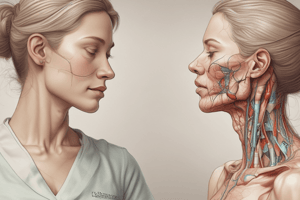Podcast
Questions and Answers
What does the frontal (coronal) plane divide?
What does the frontal (coronal) plane divide?
- Midsagittal from parasagittal
- Left from right
- Anterior from posterior (correct)
- Superior from inferior
Which body cavity is located superior to the diaphragm?
Which body cavity is located superior to the diaphragm?
- Pelvic cavity
- Thoracic cavity (correct)
- Dorsal body cavity
- Abdominopelvic cavity
What characterizes true body cavities?
What characterizes true body cavities?
- Filled with air and not fluid
- Closed, fluid-filled spaces lined with serosa (correct)
- Open to the outside environment
- Temporary in nature
Which imaging technique uses high-frequency sound waves?
Which imaging technique uses high-frequency sound waves?
What is the primary mechanism of homeostatic regulation?
What is the primary mechanism of homeostatic regulation?
What does negative feedback in a feedback system do?
What does negative feedback in a feedback system do?
In physiological terms, what is homeostasis?
In physiological terms, what is homeostasis?
What can unchecked positive feedback lead to?
What can unchecked positive feedback lead to?
What does the study of anatomy encompass?
What does the study of anatomy encompass?
Which level of structural organization includes groups of cells working together?
Which level of structural organization includes groups of cells working together?
What is indicated by the term 'Cranial' in anatomical directions?
What is indicated by the term 'Cranial' in anatomical directions?
Which anatomical position is described as lying face up?
Which anatomical position is described as lying face up?
Which of the following correctly describes the Right Upper Quadrant (RUQ)?
Which of the following correctly describes the Right Upper Quadrant (RUQ)?
In anatomical directions, what does 'Medial' mean?
In anatomical directions, what does 'Medial' mean?
What is one reason why a knowledge of human anatomy is crucial for nurses?
What is one reason why a knowledge of human anatomy is crucial for nurses?
What does the term 'Inferior' refer to in anatomical terms?
What does the term 'Inferior' refer to in anatomical terms?
Flashcards are hidden until you start studying
Study Notes
Anatomy Overview
- Study of internal and external structures of the body.
- Crucial for nurses for landmarking, assessments, communication, documentation, and understanding physiology.
Levels of Structural Organization
- Chemical Level: Involves atoms and molecules.
- Cellular Level: Smallest living unit of the body.
- Tissue Level: Groups of cells working together for specific functions.
- Organ Level: Two or more tissues combined to perform functions.
- Organ System Level: Groups of organs that collaborate for a particular function.
- Organism Level: The living individual as a whole.
Language of Anatomy
- Anatomical Position: Standard reference: standing upright, facing forward, feet together, arms at sides, palms facing forward.
- Body Positions:
- Prone: lying face down.
- Supine: lying face up.
Anatomical Directions
- Anterior: Front of the body (ventral).
- Posterior: Back of the body (dorsal).
- Superior: Above another part.
- Inferior: Below another part.
- Medial: Closer to the midline.
- Lateral: Further from the midline.
- Proximal: Closer to the point of attachment.
- Distal: Further from the point of attachment.
- Cranial/Cephalic: Toward the head.
- Caudal: Toward the tail.
- Left and right refer to the subject’s perspective.
Anatomical Regions
- The abdomen can be divided into four quadrants:
- Left Upper Quadrant (LUQ).
- Right Upper Quadrant (RUQ).
- Left Lower Quadrant (LLQ).
- Right Lower Quadrant (RLQ).
- Nine abdominopelvic regions for precise location of structures.
Sectional Anatomy
- Frontal (Coronal) Plane: Divides body anterior and posterior.
- Sagittal Plane: Divides body left and right; includes midsagittal and parasagittal.
- Transverse Plane: Divides body superior and inferior.
Body Cavities
- True body cavities are closed, fluid-filled, lined with serosa (serous membrane).
- Functions: Protect organs, accommodate changes in organs' size or shape.
- Types of Cavities:
- Dorsal body cavity.
- Ventral body cavity, including thoracic and abdominopelvic cavities.
- Thoracic cavity has right and left pleural cavities, mediastinum, and pericardial cavity.
- Abdominopelvic cavity further divided into abdominal and pelvic cavities.
Physiological Overview
- Study of body functions at various levels (chemical, cellular, tissue, organ, system).
- Understanding both anatomy and physiology is crucial for nursing practice.
Homeostasis
- Ability of the body to maintain stable internal conditions.
- Mechanisms include autoregulation and extrinsic regulation.
Feedback Systems
- Circular process of monitoring and response involving receptors and effectors.
- Negative Feedback:
- Main mechanism for maintaining stability.
- Components include a regulated variable, stressor, receptor, control center, and effector.
- Example: Thermoregulation.
- Positive Feedback:
- Reinforces the initiating stimulus, amplifying changes.
- Can lead to dangerous outcomes if unchecked (e.g., uterine contractions, blood clotting).
Studying That Suits You
Use AI to generate personalized quizzes and flashcards to suit your learning preferences.




